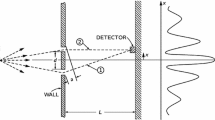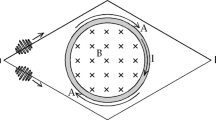Abstract
Classical electromagnetic forces can account for the experimentally observed phase shifts seen in an electron interference pattern when a line of electric dipoles or a line of magnetic dipoles (a solenoid) is placed between the electron beams forming the interference pattern.
Similar content being viewed by others
REFERENCES
G. Matteucci and G. Pozzi, “New diffraction experiment on the electrostatic Aharonov-Bohm effect,” Phys. Rev. Lett. 54, 2469–2470 (1985).
Y. Aharonov and D. Bohm, “Significance of electromagnetic potentials in quantum theory,” Phys. Rev. 115, 485–491 (1959).
R. G. Chambers, “Shift of an electron interference pattern by enclosed magnetic flux,” Phys. Rev. Lett. 5, 3–5 (1960) or G. Mollenstedt and W. Bayh, “Messung der kontinuierlichen Phasenschiebung von Elektronenwellen in kraftfeldfreien Raum durch das magnetische Vektorpotential einer Luftspule,” Naturwiss. 49, 81-82 (1962). See also the reviews by S. Olariu and I. I. Popescu, “The quantum effects of electromagnetic fluxes,” Rev. Mod. Phys. 57, 339-436 (1985), and by M. Peshkin and A. Tonomura, The Aharonov-Bohm effect (Lecture Notes in Physics, Vol. 340) (Springer, New York, 1989).
See, for example, D. J. Griffiths, Introduction to Quantum Mechanics (Prentice Hall, Englewood Cliffs, NJ, 1995), pp. 343–349.
See, for example, D. J. Griffiths, Introduction to Electrodynamics (Prentic Hall, Upper Saddle River, NJ, 1999), 3rd edn., p. 165.
Boyer, “The Aharonov-Bohm effect as a classical electromagnetic-lag effect: An electrostatic analogue and possible experimental test,” Nuovo Cimento 100B, 685–701 (1987).
See the reviews by Olariu and Popescu and by Tonomura mentioned in Ref. 3. The present author's views were expressed thirty years ago in T. H. Boyer, “Classical electromagnetic deflections and lag effects associated with quantum interference pattern shifts: considerations related to the Aharonov-Bohm effect,” Phys. Rev. D 8, 1679–1693 (1973). More recent aspects are given by T. H. Boyer, “Does the Aharonov-Bohm effect exist?'', Found. Phys. 30, 893-905 (2000); “Classical electromagnetism and the Aharonov-Bohm phase shift,” Found. Phys. 30, 907-932 (2000).
See, for example, B. Lischke, “Direckte Beobachtung einzelner magnetischer Fluss quanten in supraleitenden Hohlzylindern. III,” Z. Physik 239, 360–378 (1970). Actually, although a superconductor expells the magnetic field lines of a time-independent magnetic field in the Meissner effect, a superconductor acts similarly to a normal metal for high frequency fields. The erroneous point of view regarding the screening role of conducting materials appears on p. 426 of the review by Olariu and Popescu listed in Ref. 3 and on p. 123 of the review by Tonomura.
T. H. Boyer, “Penetration of the electric and magnetic velocity fields of a nonrelativisticpoint charge into a conducting plane,” Phys. Rev. A 36, 68–82 (1974). W. H. Furry, “Shielding of the magnetic field of a slowly moving point charge by a conducting surface,” Am. J. Phys. 42, 649-667 (1974). D. S. Jones, “The penetration into conductorsof magnetic fields from moving charges,” J. Phys. A 8, 742-750 (1975). T. H. Boyer, “Penetration of electromagnetic velocity fields through a conducting wall of finite thickness, ” Phys. Rev. E 53, 6450-6459 (1996). W. L. Schaich, “Electromagnetic velocity fields near a conducting slab,” Phys. Rev. E 64, 046605 (2001); “Surface response of a conductor: static and dynamic, electric and magnetic,” Am. J. Phys. 69, 1267-1276 (2001).
T. H. Boyer, “Understanding the penetration of electromagnetic velocity fields into conductors,” Am. J. Phys. 67, 954–958 (1999).
T. H. Boyer, “Does the Aharonov-Bohm effect exist?” Found. Phys. 30, 893–905 (2000).
T. H. Boyer, “Interaction of a point charge and a magnetic moment: Considerations related to the Aharonov-Bohm phase shift,” Found. Phys. 32, 1 (2002).
Author information
Authors and Affiliations
Rights and permissions
About this article
Cite this article
Boyer, T.H. Semiclassical Explanation of the Matteucci–Pozzi and Aharonov–Bohm Phase Shifts. Foundations of Physics 32, 41–49 (2002). https://doi.org/10.1023/A:1013896713708
Issue Date:
DOI: https://doi.org/10.1023/A:1013896713708




